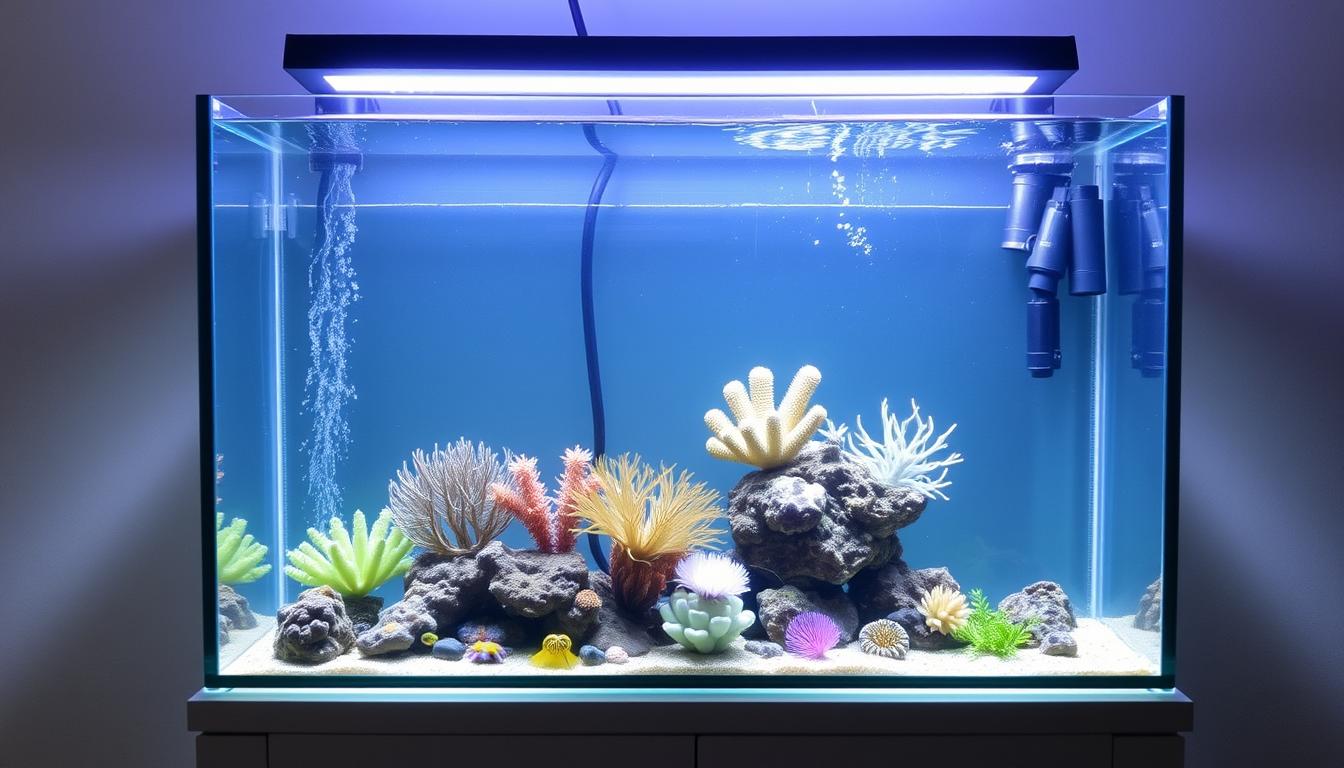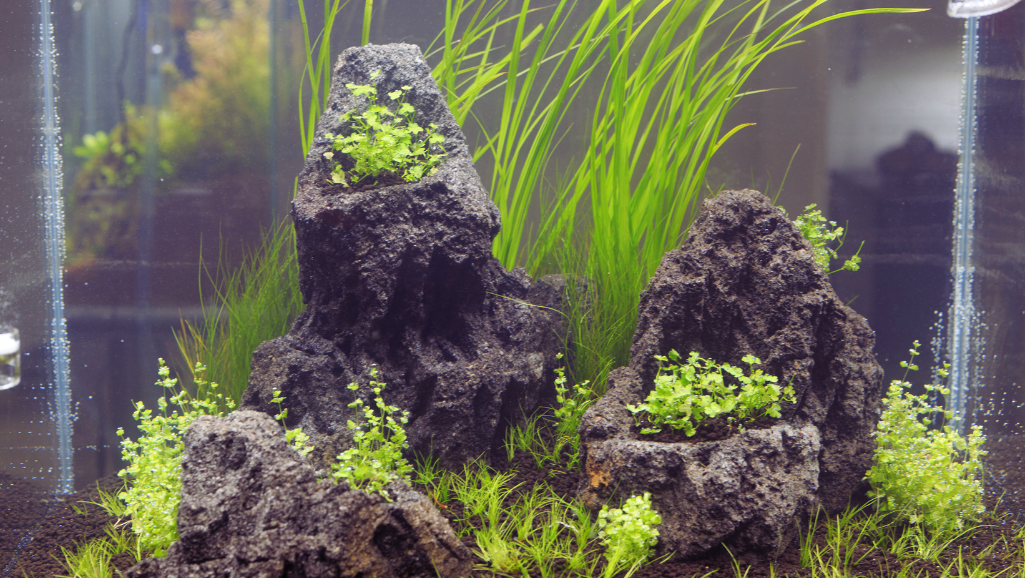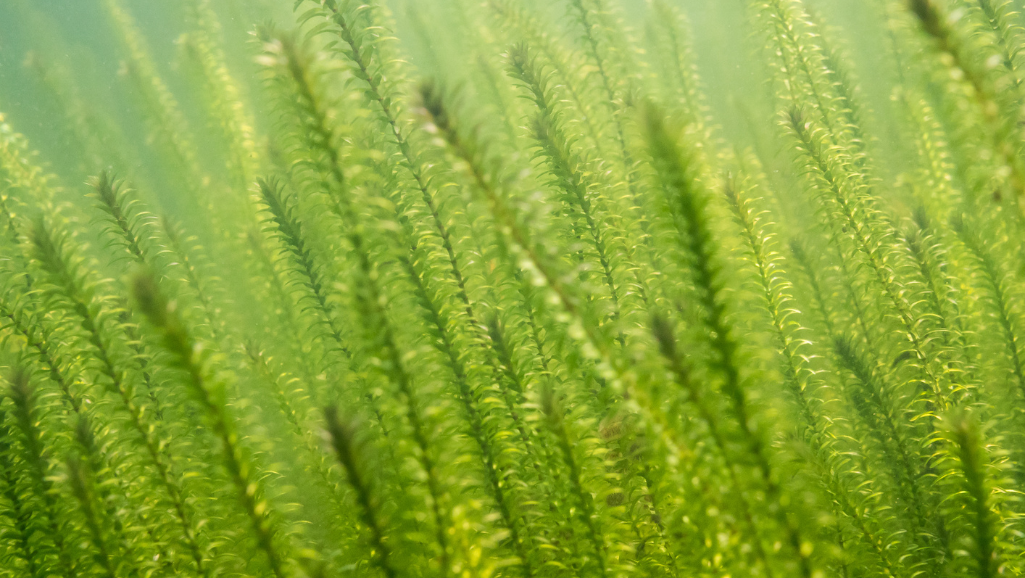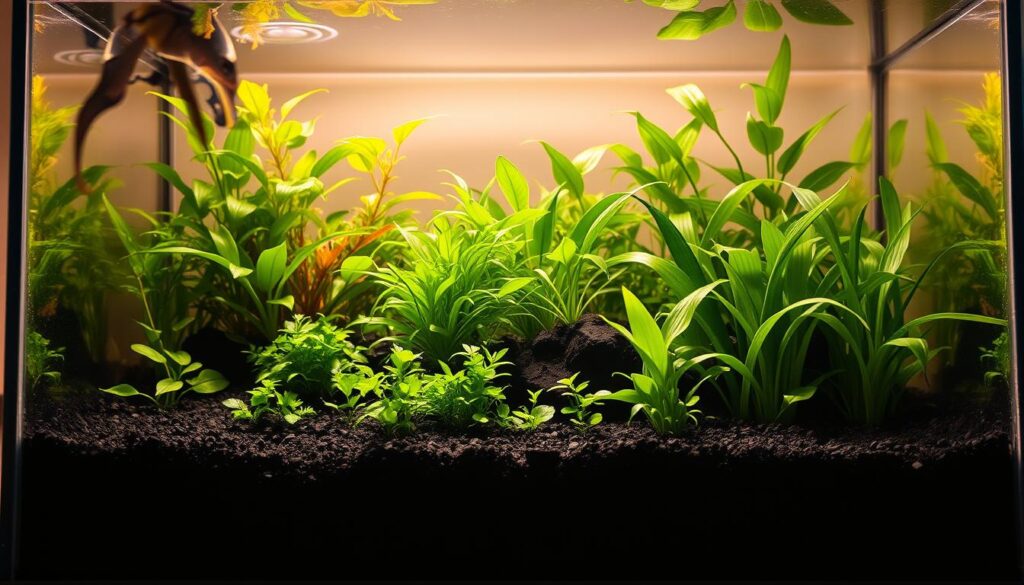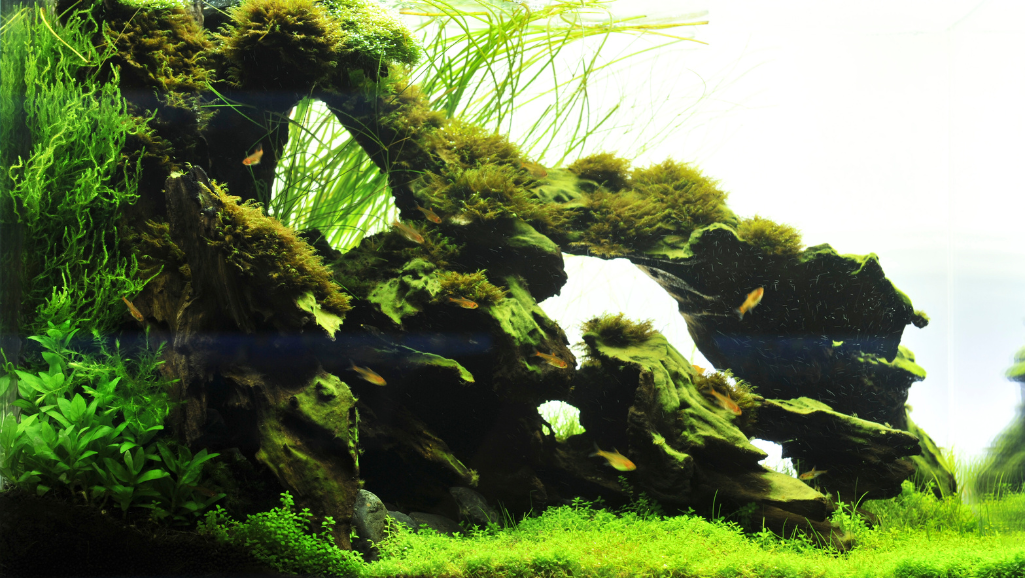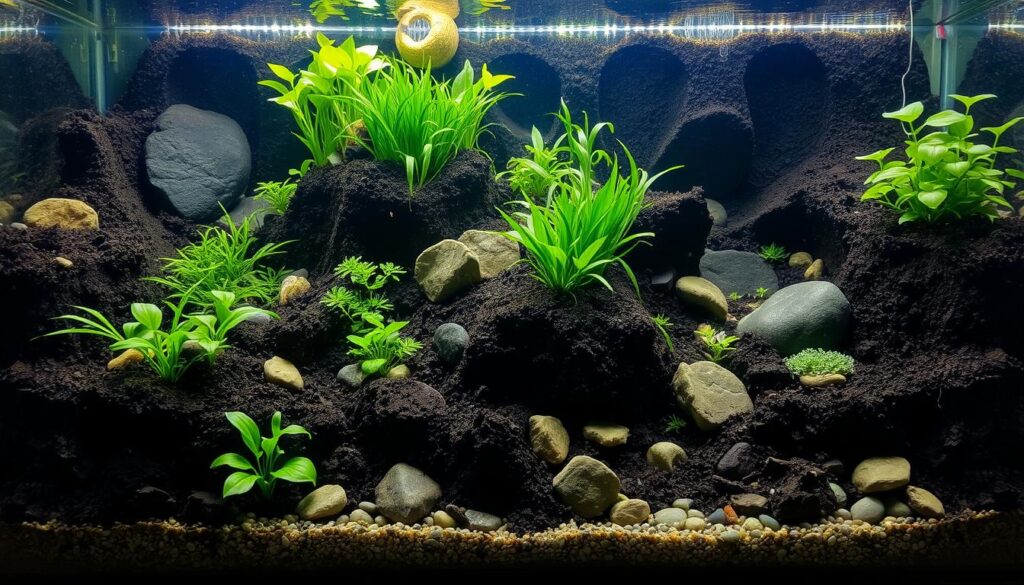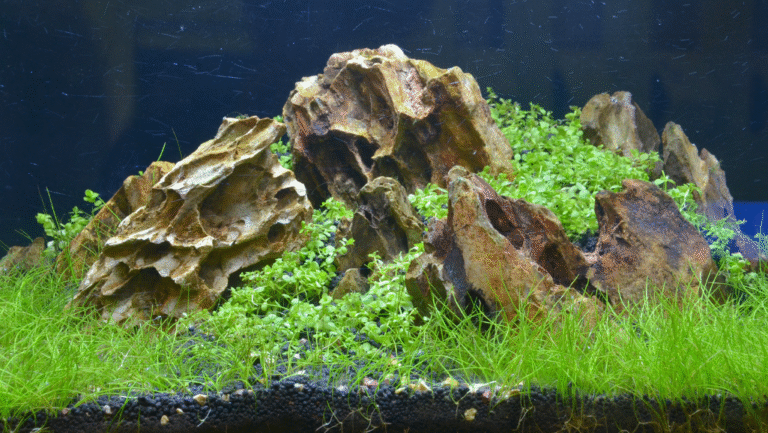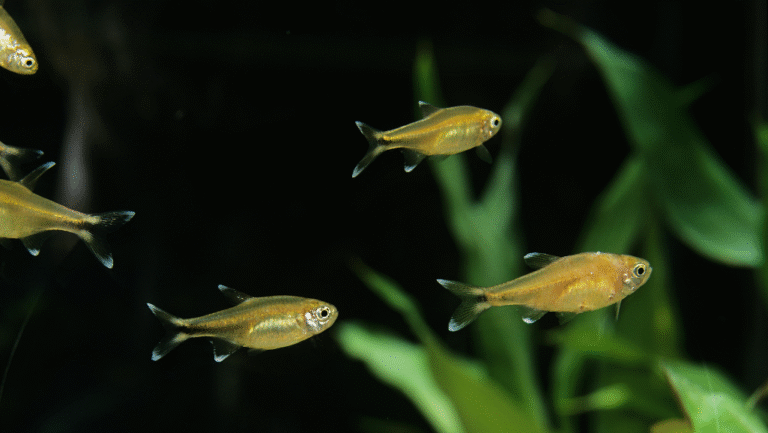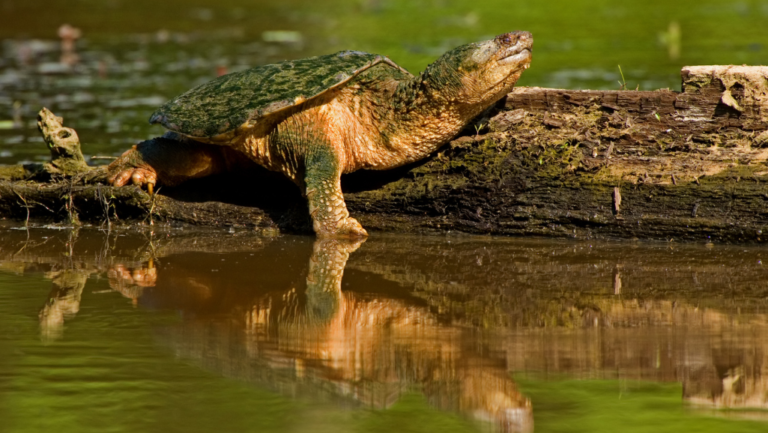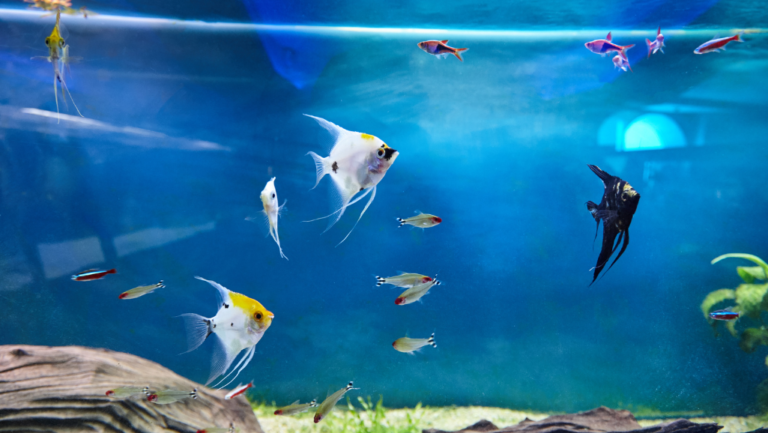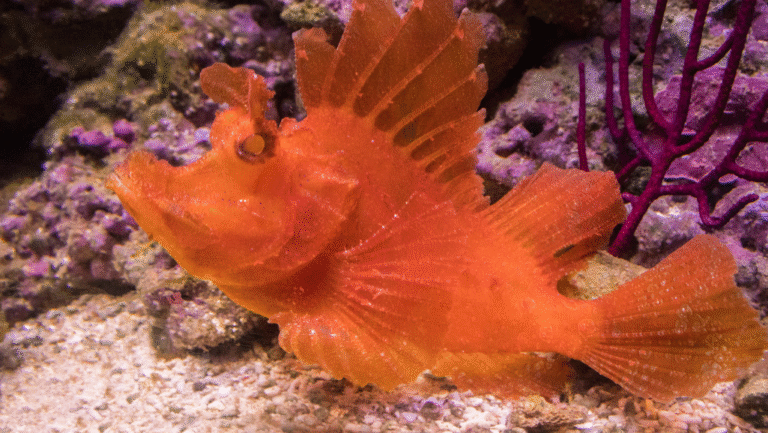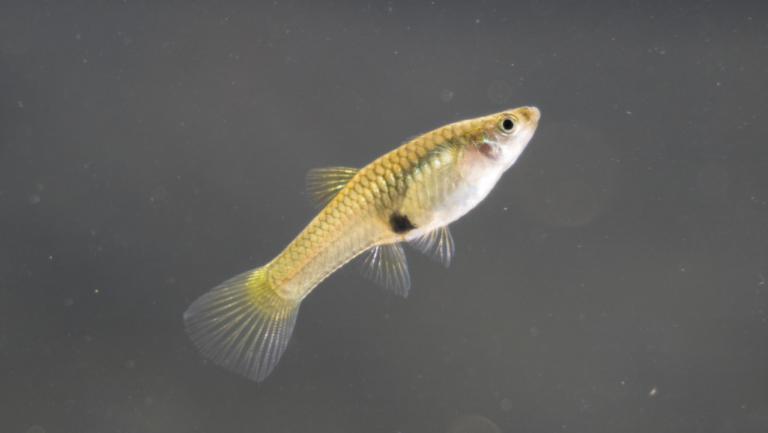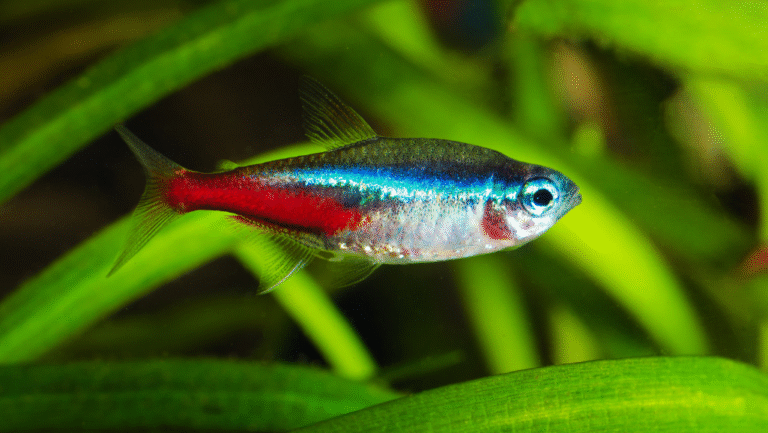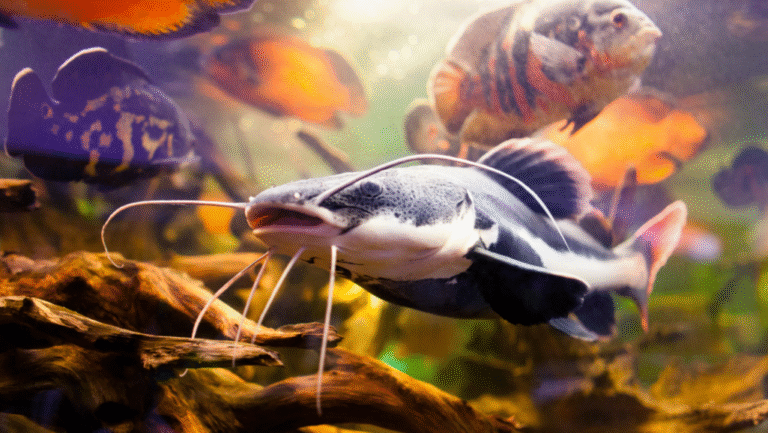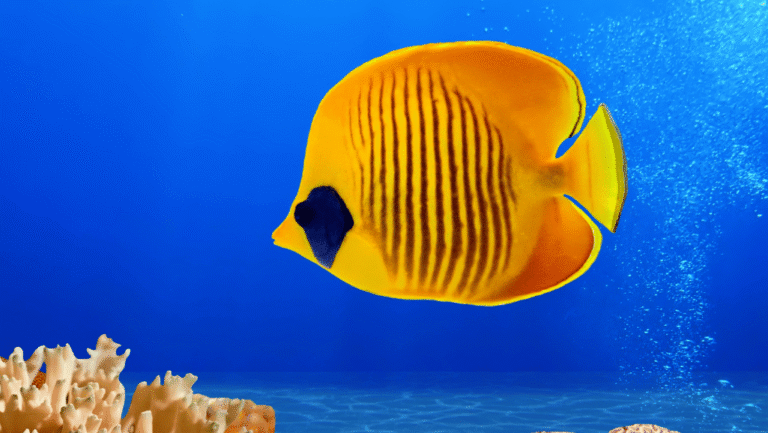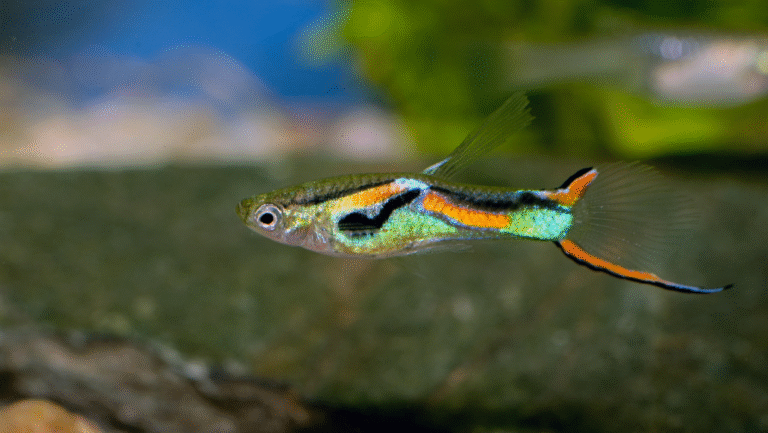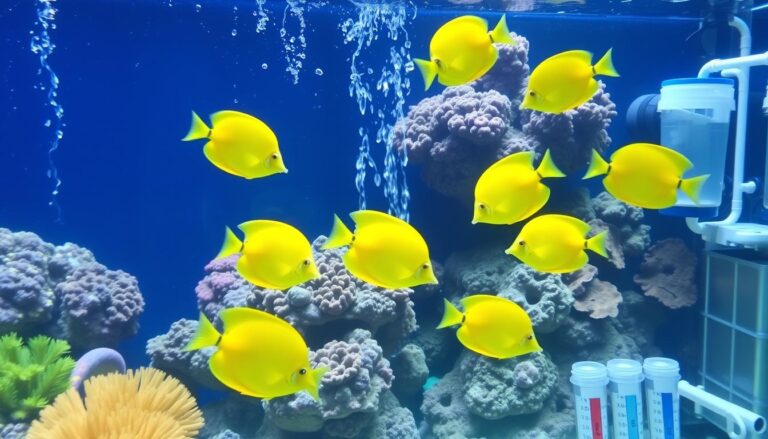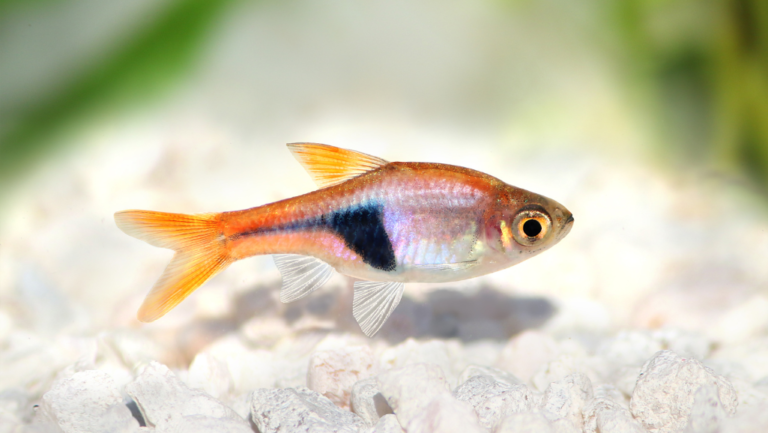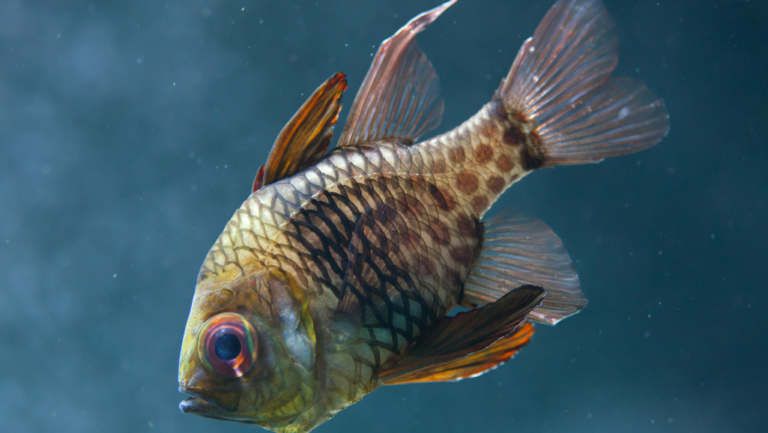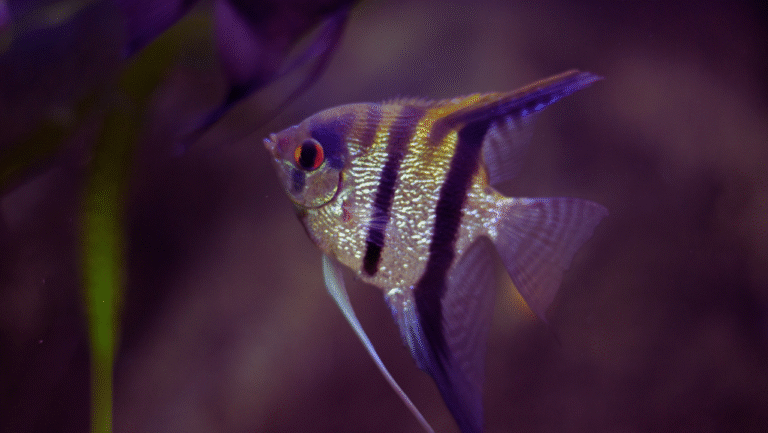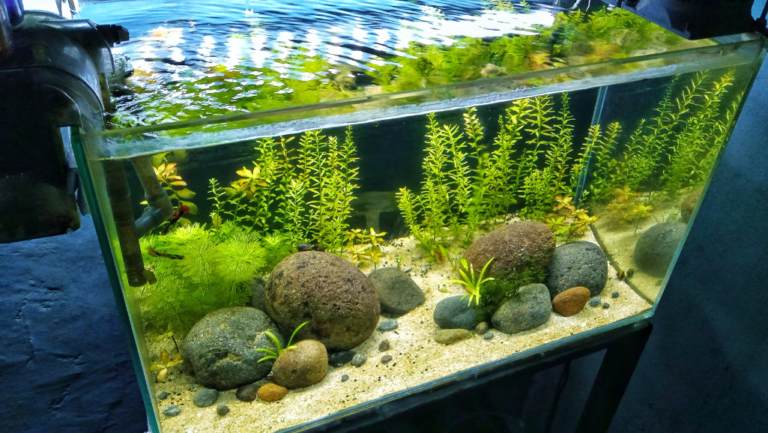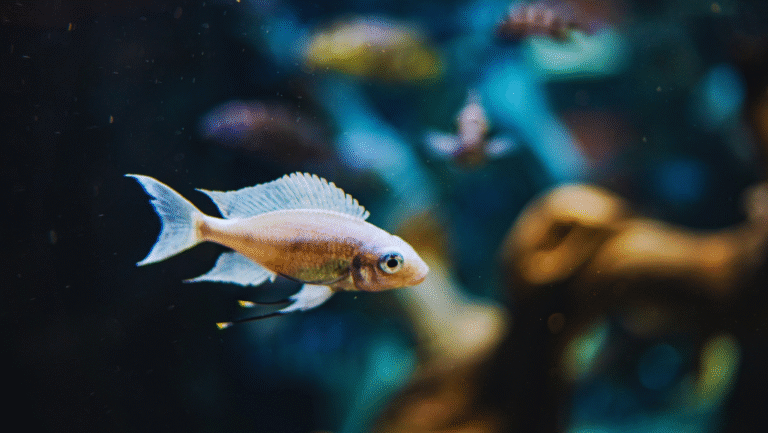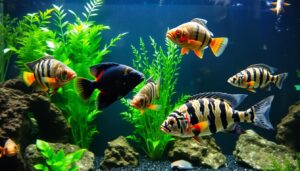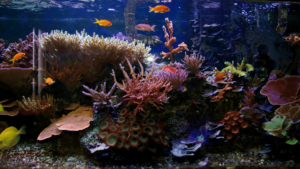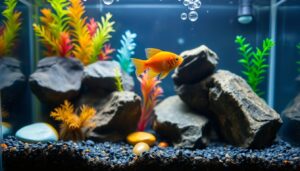Transform your tank into living art with a simple, smart approach that brings movement, color, and balance to any room. This idea shows how using ready-grown green life can give instant impact while keeping your scape flexible for future edits.
Many hobbyists buy specimens grown emersed and sold in small pots with rock wool. These hardy specimens adapt fast as they replace emersed leaves with submerged growth, making them ideal for low-tech setups.
Use removable pots to manage big species without tearing apart the planted tank. Sand and substrate choices shape both looks and maintenance, and keeping sand separate from aqua soil helps avoid messy mixes that look unnatural.
By planning placement and tools up front, you protect delicate roots and make upkeep easier. The right pots and a clear way to lift or move large pieces give you control and confidence as your oasis grows.
Key Takeaways
- Starting with potted options gives instant visual impact and flexibility.
- Removable pots let you move big species without uprooting the whole tank.
- Sand and substrate decisions affect both style and plant health.
- Emersed-grown specimens often adapt well to submerged life.
- Good planning reduces maintenance and protects roots during planting.
Why Choose Potted Aquarium Plants for Your Tank Right Now
Ready-made pots give instant fullness and long-term control. They let you test a layout without a full rescape and make routine care less disruptive.
Hidden lift-out containers are ideal for large species. You can remove a pot to trim or repot at the sink, then return it to the same spot with minimal mess. Many hobbyists favor sand for open beaches, but keeping sand separate from aqua soil during maintenance is a real challenge.
Instant impact and cleaner upkeep
- Create visual fullness fast by dropping in pre-grown plants in pots, then refine the scape at your own pace.
- Lift a pot to prune or thin growth outside the tank to avoid clouding and substrate churn.
- Move or trade specimens between tanks as designs change so plants move smoothly without uprooting neighbors.
- Lean into the like idea of sand paths while anchoring heavy feeders in nutrient-rich containers for both looks and nutrition.
- Choose the right kind and size of pot so roots can establish while remaining fully controllable in small or large tanks.
Bottom line: using removable pots reduces disturbance, limits algae flare-ups from major substrate churn, and offers a flexible way to trial new species as your hardscape matures. This is a practical way to keep your tank healthy and attractive.
Understanding Potted, Bunched, and Tissue Culture Plants
How greenery is packaged affects setup time, risk, and visual impact. Some formats give immediate rooted stability. Others offer fast massing or a sterile clean start. Choose by timeline, budget, and the livestock in your aquarium.
Potted: net containers, rock wool, and rooted stability
Plastic net pots hold rock wool tightly around roots. Rock wool keeps moisture and supports travel from shop to tank. Remove most rock wool after loosening fine roots to avoid long-term debris.
Bunched stem options for quick coverage
Bunched stem plants arrive wrapped in slim foam with plant weights. Modern weights often use magnesium-zinc alloy, which is safe for fish and shrimp.
These bunches give fast height and background cover. Trim and replant tips to thicken stands and shape the layout.
Tissue culture in sealed cups: sterile, dense, and pest-free
Tissue culture comes in sealed cups filled with nutrient gel. They arrive sterile and usually contain a lot of tiny plantlets.
Rinse off gel, separate portions, and plant evenly to avoid shading. This format is ideal for sensitive livestock or when you want a clean start.
“Sterile starts reduce the chance of hitchhikers and let you plant densely for fast visual impact.”
- Match each format—net pots, bunches, or cups—to your timeline.
- Remove excess rock wool but protect delicate roots during prep.
- Rinse tissue culture gel and tease apart portions before planting.
Pros and Cons: Potted vs Tissue Culture vs Bunched
Choosing the right format for your greenery changes how fast a scape fills in and how much care it will need.
Strength and height benefits for low-tech setups
Potted and bunched options give immediate height and robust stems that thrive in low-tech tanks without CO2.
They adapt by shedding emersed leaves and producing new submerged growth, so you often see fast stabilization and visible growth.
Sterility, portions, and storage for tissue culture cups
Tissue culture cups arrive sterile and free of pests and algae, with a lot of small portions ready to blanket a carpet area.
Store them in a bright, cool spot and plant while fresh to cut melt risk and boost early vigor.
Transition, melt, and timelines to expect
“Expect some melt as emersed leaves transition; steady new leaves show successful adaptation.”
- Choose robust stems for quick height and reach to light.
- Opt for cups when you want a clean, uniform carpet with minimal hitchhikers.
- Combine formats—anchors from pots, ground cover from cups—to balance speed and cleanliness.
Potted Aquarium Plants: Core Buying Criteria
Start with the tank’s dimensions and lighting so every selection fits the final scape and care plan.
Tank size, light, and CO2 — matching choices to your setup
Measure light and space first. A small tank with modest fixtures calls for slow, low-demand greenery. A larger, high-light tank with CO2 lets fast growers and carpet species thrive.
Robust potted and bunched options often acclimate better in low-tech tanks and need much less intervention than delicate starters. Tissue culture is the cleaner way for high-energy, high-CO2 layouts.
Growth habit and leaves — pick for foreground, midground, background
Choose the right leaf texture and size to add depth. Broad leaves create mass. Fine leaves add detail. Crinkled foliage gives contrast.
- Start with tank dimensions and light output to match mature size and growth habit.
- Favor hardy options for low-tech tanks; they stabilize quickly and need less trimming.
- Match fast growers to strong light and CO2 so carpets and stems fill in predictably.
- Consider root spread so clumps don’t crowd hardscape as they thicken.
- Balance anchors in containers with softer fillers to soften lines and ease moves.
“Read new submerged leaves as the best cue that a specimen is settling into its environment.”
Plan for growth rates so your weekly trimming keeps the scape tidy. Watch leaves and new shoots; they tell you if nutrient and lighting choices are right.
Substrate Choices: Sand, Aqua Soil, or Hybrid Approaches
The foundation you choose—soft sand, rich soil, or both—defines how the tank will behave. This decision shapes the look, rooting, and the effort you put into care.
Sand creates bright open areas and paths that make a scape feel larger and cleaner. It suits minimalist layouts and foregrounds where fine texture matters.
Sand aesthetics and open areas vs aqua soil nutrient density
Aqua soil supplies steady nutrients for root feeders and heavy growers. Use nutrient soil where demanding species need a boost. Combine both for contrast: sand for beaches, soil for beds.
Keeping sand and aqua soil separate: practical challenges
Routine maintenance often causes a messy mix at the bottom. Rocks, wood, or edging help reduce spillover, but barriers and contained zones work best.
- Choose sand for clear paths and open visual space.
- Use soil where roots need sustained fertility.
- Contain beds with pots or edging to avoid an unwanted mix.
- Plan flow so sand isn’t scoured and soil doesn’t creep into open areas.
“Hybrid layouts give both style and substance, but accept that long-term upkeep requires thoughtful barriers.”
Potting Media, Rock Wool, and Root Care
Rock wool is a spongy support that holds moisture and adds weight in net pots so specimens travel and display without damage.
Prepare gently: lift the specimen from its net container and peel back layers of rock wool. Use fingers first, then fine tweezers for stubborn bits.
Rinse roots under temperate running water to remove loose fibers. Keep the root zone wet so delicate hairs do not dry out.
- Understand rock wool’s role: moisture retention and ballast for retail display.
- Peel layers and tease roots—tiny remnants of rock wool are harmless; protect root integrity over perfection.
- Trim overly long roots to encourage branching and faster anchoring after planting.
- Match potting mix to the species—lighter mixes suit fine root systems; richer mixes feed heavy feeders.
- Click expand your toolkit with fine tweezers and a shallow tray to catch loose fibers as you work.
“Trim mushy sections back to healthy tissue and bundle roots lightly for easier placement.”
Do a quick dip inspection for pests before planting. This small routine protects water quality and promotes new growth.
How to Prep and Plant Your Potted Plants
A calm, methodical setup prevents floaters and sets roots up to thrive. Remove each specimen from its plastic mesh gently. Peel back rock wool, teasing roots free with fingers before using tools.
Rinsing, tweezers use, and planting depth for stable roots
Rinse prepared portions thoroughly under temperate water and keep roots moist until planting to avoid shock. Use planting pinsettes to grasp the lower root zone, insert halfway into the soil, angle down slightly, then release tension and withdraw so the crown stays seated.
Planting in soil vs sand: anchoring methods and spacing
In nutrient soil, plant a touch deeper to resist buoyancy. In sand, add gentle anchoring or plant weights at the bottom to hold cuttings steady.
- Space specimens to prevent mature leaves from shading neighbors and to allow flow around lower nodes.
- For grouped layouts, stagger placement in a zig-zag to create natural rhythm and maximize substrate contact.
- Contain mixed substrate zones or use small pots to stop soil from leaching into sand beds.
Final steps: lightly waft water to settle grains around roots without exposing crowns, then do a partial water change to clear haze and give the new additions a calm first night. For extra guidance on technique, consult this step-by-step planting guide.
Smart Scaping: Using Pots, Cups, Lava Rock, and Mesh
Layer modular green modules behind rocks to keep large-rooted specimens easy to lift and groom. This approach keeps the main scape intact while letting you perform sink-side maintenance on big crowns.
Hidden containers for large specimens
Conceal pots behind hardscape so large Cryptocoryne and similar species can be lifted without uprooting neighbors. Hidden liners let those mature crowns be groomed at the sink, reducing cloudiness and substrate churn. Use invitro cups or small nursery liners inside decorative vessels for tidy, modular beds.
Tying moss to rock or mesh for easy trimming
Tie portions of moss with cotton or thin thread to lava rock or small bent stainless mesh. These little green pads sit on shelves or branch forks and can be removed to trim and rinse outside the tank.
- Hide pots behind stones so big-rooted specimens come out cleanly for pruning.
- Use cups as liners in decorative containers for neat, movable modules.
- Tie moss with thread to rock or mesh so modules are portable and low-mess.
- Group units to protect sand paths and rotate them seasonally—click expand your layout without a full rescape.
“Modular scapes let you evolve a layout with minimal downtime and maximum visual punch.”
Secure thread neatly so lines vanish as growth fills in. Build layered rocks and mesh to shape flow and cut dead spots. Embrace this idea and click expand your creativity with modular units that let your scape change gracefully as you care for it.
Care and Maintenance: Growth, Trimming, and Water Changes
Expect an adjustment period as emersed foliage gives way to fresh submerged growth. Emersed-grown stock often shows melt; steady new shoots are the real signal that recovery is under way.
Prune decaying leaves promptly so they do not foul water and slow recovery. For stem plants, top and replant cuttings to thicken stands and keep the visual line crisp.
Manage runner types by thinning or relocating daughter plants so mother crowns do not get crowded. Regular repositioning keeps flow and light balanced around each specimen.
- Expect melting as emersed leaves transition; new growth means success.
- Schedule routine water changes to export organics and stabilize parameters.
- Tweak flow so nutrients reach all leaves and debris won’t collect in dead spots.
- Keep tools clean and make precise cuts to reduce infection risk.
- Watch for algae early and adjust light or dosing before it spreads.
“Use the way new tips perk and color deepens as feedback to refine your routine.”
Common Mistakes to Avoid with Potted Plants
A few common setup mistakes quietly undermine growth and invite extra algae battles.
Remove packing media before planting. Large clumps of rock wool and other packing left in the water create waste and cloud filters. Peel and rinse away as much as practical so your filtration doesn’t have extra work.
Planting depth and crowding
Avoid planting too shallow. Seat crowns and cover roots so portions won’t lift after a water change.
Give stems room to breathe. Crowded bases shade lower nodes, weaken stems, and invite algae growth.
Mixing substrates without barriers
When combining sand and soil, use edging or containers to stop mixing. Otherwise the bottom blurs and maintenance becomes harder.
“Plan for adult size, not just today’s pot — it saves work later.”
- Don’t leave large clumps of packing media; remove excess promptly.
- Ensure depth and spacing so additions root, not float.
- Use barriers to keep sand and soil defined.
- Choose the kind of anchor or weight that holds items stable until they root in.
- Click expand your checklist: remove media, confirm depth, verify spacing, then tidy.
- Click expand your spacing to allow mature leaf spread and reduce rescues later.
Troubleshooting: When Plants Don’t Thrive
The quickest way to diagnose a struggling specimen is to look at the roots first, not the leaves. Healthy root tissue feels firm and ranges white to tan. Mushy or blackened roots signal rot and need pruning right away.
Identify root vs leaf issues: emersed-to-submerged transitions often shed older leaves. Persistent leaf failure points to light, flow, or substrate nutrition problems. Adjust intensity or shorten photoperiod before changing many other variables.
Dealing with pests, pathogens, and algae
Use sterile sources when possible. For non-sterile stock, a careful clean or a controlled dip reduces hitchhikers. Tissue culture lowers pathogen risk at purchase.
- Diagnose from the root up: firm roots are healthy; mushy roots mean rot.
- If leaves keep failing, reassess light and substrate nutrition.
- Trim to sound roots and replant portions into stable zones of the tank.
- Balance macro and micro dosing so plants get nutrients while algae loses its advantage.
“Watch new leaves for improved color and turgor — they are the best sign corrections are working.”
One practical way: change one variable at a time. Move a specimen to richer substrate or add root tabs, then watch new roots and leaves before making another change.
Top Picks by Tank Type and Goal
Prioritize hardy specimens for low-effort setups and sterile starts for high-demand layouts. This helps you choose with confidence whether you want quick impact or a clean, uniform cover.
Low-tech tanks without CO2: robust choices
Lean on tough, steady growers that handle variable light and modest care. Swords, Cryptocoryne, and hardy stems adapt quickly and give instant height.
- Use potted or bunched forms to drop in volume and structure fast.
- Bunched stems fill backgrounds; top and replant tips to thicken stands over time.
- These low-maintenance picks need much less intervention and reward steady routines.
High-tech layouts: sterile starts and dense coverage
For a brand-new high-demand setup, choose tissue culture. Invitro cups deliver a sterile slate and a lot of small portions for uniform spread.
- Favor invitro carpets like Monte Carlo or dwarf hairgrass for consistent coverage without hitchhikers.
- In shrimp-focused displays, sterile starts reduce contamination risk and protect colonies.
- Click expand your shortlist by matching species to light and water chemistry to avoid trial and error.
“Match plant vigor to fish load and maintenance cadence so growth stays in balance week after week.”
Tip: For established displays, add single statement pieces as potted plants to avoid disturbing roots. Click expand your palette with mixed textures so each shelf and depth feels layered and intentional.
Tools and Materials Checklist for Planting Success
A tidy bench and the right kit make every planting session faster and less stressful. Gather tools before you begin so work near the tank stays calm and clean.
Pinsettes, weights, thread, and scaping basics
Pinsettes are essential for precise placement. Grip the lower root portion, insert halfway into soil, turn the tips downward slightly, release, and withdraw to seat the crown without crushing stems.
- Stock fine pinsettes for locked placement and minimal disturbance.
- Keep magnesium-zinc plant weights to wrap rhizomes and stop floaters until roots hold.
- Use thread to tie moss and small epiphytes to rocks or stainless mesh for removable modules.
- Organize pots, liners, and a single plastic tray to stage work and cut mess.
- Prepare a cup of clean water for rinsing gel from invitro portions and wetting roots during prep.
“Lay out tools in order—prep, plant, tidy—so sessions flow smoothly and efficiently.”
Tip: choose porous lava rocks for grip and lightweight support. Click expand your toolkit with curved scissors and a soft brush. Click expand your routine by staging a towel and waste container beside the tank.
Conclusion
Build layers that make the hard work invisible: open sand beds, hidden supports, and focused beds let your tank read as calm and deliberate.
Use removable pots to lift and prune without uprooting neighbors. Blend sand for open foregrounds and soil-fed modules in pots to feed hungry roots while keeping paths clean.
Start clean when needed with in vitro starts—see more on sterile options in vitro starts. Rinse media, trim long roots, and plant with pinsettes for precise placement and clear water.
You’re ready to choose confidently. Pick the idea and the way that match your routine. Click expand your layout over time and enjoy a living gallery that grows with you. Click expand.
